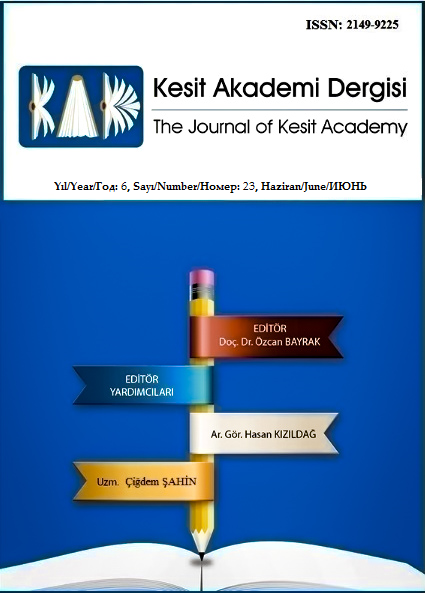Author :
Abstract
Osmanlı Devleti’nin elinde bulunan Anadolu topraklarının üzerindeki ticaret yolları, sanayi devrimi ve coğrafi keşiflere kadar dünya ticaretinde önemli bir konuma sahipti. Bu ticaret yolları, geçtikleri şehirleri önemli ticaret alanlarına dönüştürmüştür. Osmanlı Devleti bu şehirlerde kendine özgü ve merkezinde bedestenlerin olduğu çarşı sistemleri oluşturmuştur. Bedestenler ile ilgili yapılmış çalışmalar incelendiğinde genellikle tekil olarak, Osmanlı döneminde bedestenlerin önemi ve restorasyon önerileri gibi konular araştırılmıştır. Bu çalışmada Osmanlı döneminde Anadolu toprakları üzerinde inşa edildiği tespit edilen 49 adet bedestenden, yok olanlar ve günümüze kadar ulaşmış olanların bu topraklar üzerindeki dağılımlarını haritalayarak, günümüze kadar ulaşmış olanların ise mevcut işlevleri üzerinden bir gruplandırma denemesi yapılmış ve yeniden işlevlendirilen bazı bedestenlerin işlevleriyle olan uyumları da araştırılmıştır. Bu çalışmanın amacı somut kültürel mirasın korunması için kullanılan gruplandırma sistemine yeni bir açılım olarak Anadolu bedestenleri üzerinden mecut durum, işlev ve restorasyon tarihlerine bağlı grupladırma sistemi oluşturmaya çalışılmaktadır.
Keywords
Abstract
The trade routes on the Anatolian lands owned by the Ottoman Empire had an important position in world trade until the industrial revolution and geographical discoveries. These trade routes have transformed the cities they pass into into important trade areas. The Ottoman Empire has created its own bazaar systems that are unique and centered in the city. When the studies about bedestens are examined, subjects such as the importance of bedestens and restoration suggestions were researched singularly. In this study, a grouping experiment was made by mapping the distributions of 49 destroyed ones that were found to be built on Anatolian lands during the Ottoman period, the ones that have disappeared and the ones that have survived until today, and the compatibility of some of the functioned bodies with the functions that have been re-functioned. In this study, as a new opening to the grouping system used for the protection of the cultural heritage, it is tried to create a grouping system based on the current situation, function and restoration dates over Anatolian bazaars.
Keywords
- Ahunbay, Z. (2009). Tarihi Çevre Koruma ve Restorasyon (5). İstanbul: Yem Yayınları
- Akar, T. (2009). Osmanlı Kentinde Ticari Mekanlar: Bedesten, Han, Arasta, Çarşı Mekanları Literatür Değerlendirmesi. Türkiye Araştırmaları Literatür Dergisi, 7(13): 267-292
- Atalan, Ö. ve Arel, H.Ş. (2016). 15. ve 16. Yüzyıllara Ait Osmanlı Han Yapılarının Mekansal Analizi, Turkısh Studies, 11(2). s.217-228
- Baş, A. ve Bozkurt, T. ( 2003). Konya Bedesteni. Selçuk Üniversitesi Sosyal Bilimler Enstitüsü Der- gisi, (10), 507-529
- Bilecik, G. (2016) Fetihten Sonra İstanbul’da Ticaret Yapılarının Gelişimi, Türkler Ansiklopedisi, 10: 764-770
- Cezar, M. (1985). Tipik Yapılarıyla Osmanlı Şehirciliğinde Çarşı ve Klasik Dönem İmar Sistemi, İstan- bul: Mimar Sinan Üniversitesi Yayınları
- Çekül Vakfı,(2010). Yerelden Ulusala Ulusaldan Evrensele Koruma Bilincinin Gelişim Süreci, İstan- bul:Stil Matbaacılık
- Erkal, N. (2015). İstanbul Erken Dönem Osmanlı Mimarisi. C. Yılmaz (ed). Antik çağdan 21. Yüz- yıla Büyük İstanbul Tarihi Cilt 8 -Mimari, ( s. 80-139). İstanbul: Mas matbaacılık
- Eyice S.(1992). İslam Ansiklopedisi, C.5:302-311
- Halaç, H. ve Alemdar, E.E. (2019). Coğrafi İşaretlerin Yeniden İşlevlendirmeye Katkıları: Bolu Yukarı Taşhan. JAVS Studies, 5(4): 609-622
- İnalcık, H. (1980) The Hub of The City: Bedestan of İstanbul. International Journal of Turkish Studies,1(1):1-17
- İnalcık, H. (1993). İstanbul'un İncisi: Bedesten, haz. M. Özel, İktisat ve Din, İz Yayıncılık, İstanbul: 119-136
- Küpeli, Ö. (2008) Osmanlılar ve Doğu Ticaret Yolları Üzerine (XV-XVII. Yüzyıllar). Nilgün Nurhan K., Latif D. ve Özer K.(editörler), Prof.Dr. Necmi Ülker’e Armağan içinde (s. 391-405).İzmir: Meta Basım ve Matbaacılık
- Öncel, F.(2007). Geleneksel Ticaret Dokusu İçinde “Kayseri Hançerli Sultan Vakfı Bedesteni’nin Koru- ma Sorunları ve Değerlendirilmesi. Yayınlanmamış Yüksek Lisans Tezi. İstanbul:Yıldız Teknik Üniversitesi, Fen Bilimleri Enstitüsü.
- Öncel, F.(2014). Osmanlı Bedestenleri Bağlamında “Kayseri Hançerli Sultan Vakfı Bedesteni, Megaron, 9(1):55-69
- Özdeş, G. (1998). Türk Çarşıları (2), Ankara: Tepe Yayınları
- Sönmez: (2015). Tanzimata Giden Yolda Bir Osmanlı Kenti: Sivas(1777-1839). Yayınlanmamış Dok- tora Tezi. Ankara: Hacettepe Üniversitesi, Sosyal Bilimler Enstitüsü
- Saf, H.O. ve Ergül, E.,(2019), Osmanlı Toplumu Sosyal Yapısının Kent Düzenindeki Temsili. Sketch Journal of City and Regional Planning. 1(1), s, 15-34
- Şahinalp, M.S. ve Günal, V.,(2012), Osmanlı Şehircilik Kültüründe Çarşı Sisteminin Lokasyon ve Çarşı İçi Kademelenme Yönünden Mekansal Analizi, Milli Folklor Dergisi ,93: 149-168
- http-1: https://www.fikriyat.com/galeri/tarih/osmanlida-ticaretin-kalbi-bedesten (Erişim Tari- hi:16.05.2020)
- http-2: http://www.tarihikentlerbirligi.org/koruma-projeleri-destegi/200-ortak-200-eser- programi/ (Erişim Tarihi:22.05.2020)
- http-3: http://www.tarihikentlerbirligi.org/koruma-projeleri-destegi/3-yilda-300-eser-programi/ (Erişim Tarihi:22.05.2020)
- http-6: https://www.kulturportali.gov.tr/turkiye/bursa/gezilecekyer/yildirim-beyazid- bedesteni (Erişim Tarihi:15.05.2020)
- http-8: https://tr.foursquare.com/v/tarihi-bedesten- %C3%A7ayhane/5b087746419a9e002cdaa358 (Erişim Tarihi:22.05.2020)
- http-9: https://www.mynet.com/500-yillik-bedestende-yillar-sonra-ilk-etkinlik- 180101645960#9410129 (Erişim Tarihi:13.05.2020)
- http-10: https://www.tripadvisor.com.tr/LocationPhotoDirectLink-g781292-d7190478- i311714426-Cem_Sultan_Bedesteni_RestaurantKastamonu_Kastamonu_Province_Turkish_Bla.html (Erişim Tarihi:13.05.2020)
- http-11: https://www.tripadvisor.com.tr/Restaurant_Review-g1600795-d4893823-Reviews- Bedesten_OsmanlI_MutfagI-Amasya_Amasya_Province.html (Erişim Tarihi:22.05.2020)
- http-12: https://www.aa.com.tr/tr/tarihi-yasatan-carsilar/gaziantepin-tarihi-avmleri- bedestenler/1250290 (Erişim Tarihi:16.05.2020)
- http-14: https://gazetemerhaba.com/bir-tarih-yok-oluyor/ (Erişim Tarihi:17.05.2020)
- http-15: https://www.milliyet.com.tr/yerel-haberler/afyonkarahisar/restore-edilen-tarihi- bedesten-carsisi-esnafindan-pankartli-tesekkur-11595494 (Erişim Tarihi:17.05.2020)
- http-17: https://www.kulturportali.gov.tr/turkiye/amasya/gezilecekyer/amasya- bedesten(Erişim Tarihi:17.05.2020)
- http-18: http://www.buyuktire.com/haber-tarihi_tire_bedesteninde_otantik_pazar_kurulacak- 8631.html (Erişim Tarihi:13.05.2020)
- http-21: https://www.kulturportali.gov.tr/turkiye/tokat/gezilecekyer/arastali-bedesten-tokat- muzes (Erişim Tarihi:13.05.2020)





